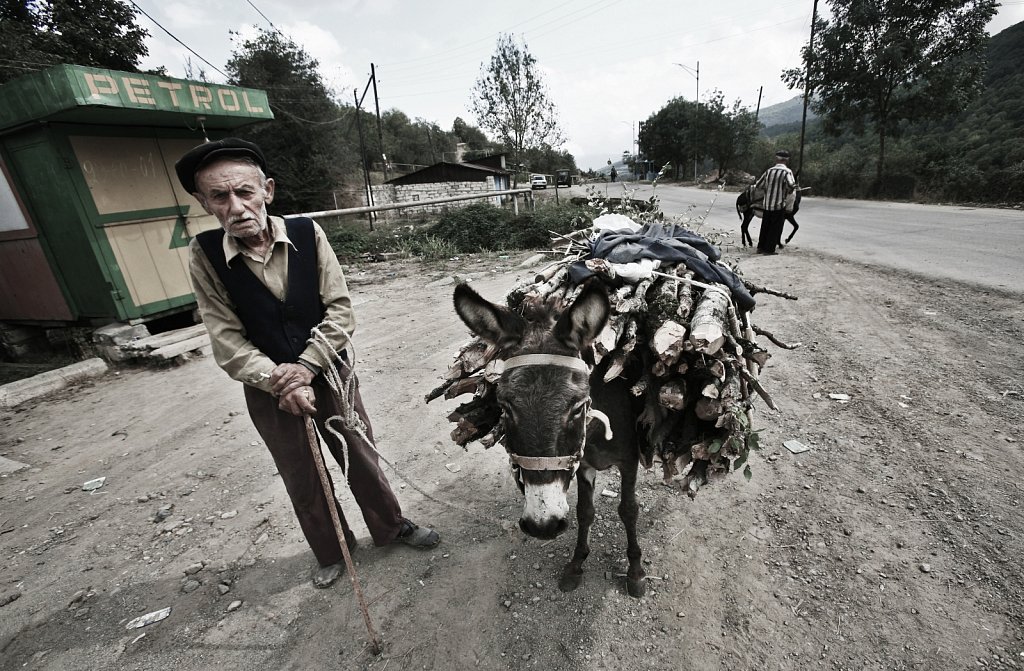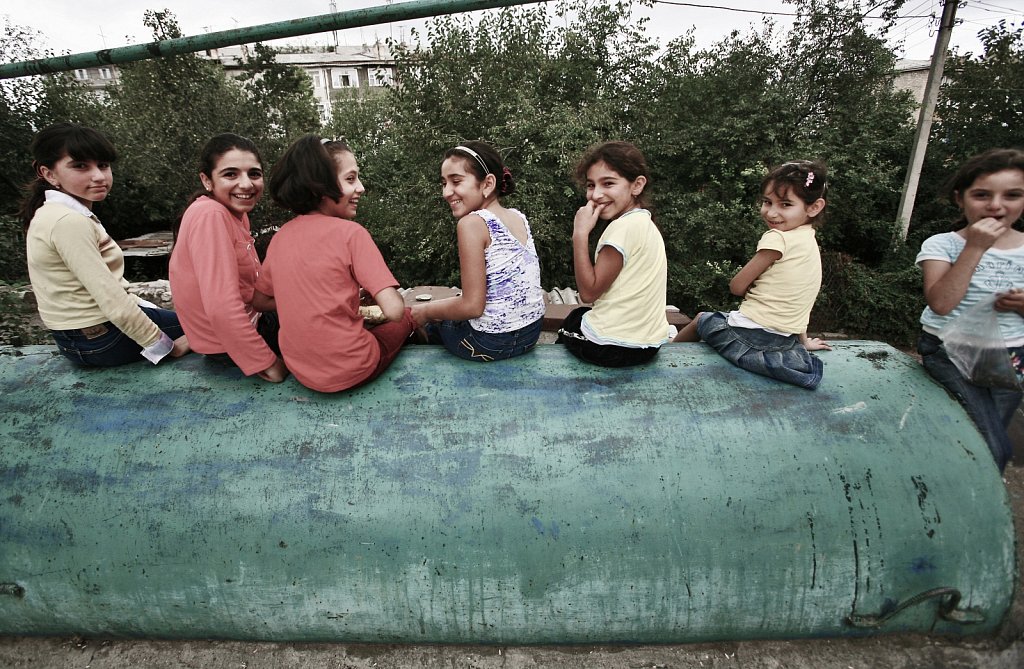
Nagorno-Karabakh
A group of workers rests during the lunch break inside a ruined building in the city of Shushi. Before the Nagorno-Karabakh War the city was the main cultural center of Karabakh, also known as “Paris of the Caucasus”. With more than three quarters of the buildings being destroyed during the war, the city has begun the reconstruction of historical buildings with a special architectural and historical value. Shushi, Nagorno-Karabakh, 18 September 2008.

Nagorno-Karabakh
A saleswoman cracks nuts in a food market in Stepanakert. With a population of 140.000, the majority being Armenians, Nagorno Karabakh Republic aims to achieve political and economical stability. The high unemployment rate, low salaries and the lack of opportunities for the youngsters make the unrecognized republic to be a hard place to live. Stepanakert, Nagorno-Karabakh, 20 September 2008.

Nagorno-Karabakh
Student Bella Gasparyan (age 10) plays on kanun instrument during a school class in the Khomitas Musical School from Stepanakert. Besides learning the classical instruments, the pupils also learn how to play to traditional instruments like duduk, kanun, zurna, oud or saz. Stepanakert, Nagorno-Karabakh, 20 September 2008.

Nagorno-Karabakh
A new married couple enters the restaurant to celebrate, downton Stepanakert. With a population of 140.000, the majority being Armenians, Nagorno Karabakh Republic aims to achieve political and economical stability. One of the Gouvernament's program targets to stimulate marriage and birth, every new formed family receives cash payments for each baby born, with the aim of repopulating the region after the devastating 1991-1994 war. The high unemployment rate, low salaries and the lack of opportunities for the youngsters make the unrecognized republic to be a hard place to live. Stepanakert, Nagorno-Karabakh, 20 September 2008.

Nagorno-Karabakh
An old man carries woods on his donkey on a street in the village Vank, Martakert region. With a population of 140.000, the majority being Armenians, Nagorno Karabakh Republic aims to achieve political and economical stability. The high unemployment rate, low salaries and the lack of opportunities for the youngsters make the unrecognized republic to be a hard place to live. Village Vank, Martakert region, Nagorno-Karabakh, 20 September 2008.

Nagorno-Karabakh
A few women wait in a bus station downtown Stepanakert. With a population of 140.000, the majority being Armenians, Nagorno Karabakh Republic aims to achieve political and economical stability. The high unemployment rate, low salaries and the lack of opportunities for the youngsters make the unrecognized republic to be a hard place to live. Stepanakert, Nagorno-Karabakh, 20 September 2008.

Nagorno-Karabakh
Teacher Nona Valerigna (age 33) gives instructions on kanun instrument, to her student Bella Gasparyan (age 10) during a school class in the Khomitas Musical School from Stepanakert. Besides learning the classical instruments, the pupils also learn how to play to traditional instruments like duduk, kanun, zurna, oud or saz. Stepanakert, Nagorno-Karabakh, 20 September 2008.

Nagorno-Karabakh
A saleswoman makes "janghialov hats", a traditional dish made by a mix of 7-8 tipes of greens covered in dough, in a food market in Stepanakert. With a population of 140.000, the majority being Armenians, Nagorno Karabakh Republic aims to achieve political and economical stability. The high unemployment rate, low salaries and the lack of opportunities for the youngsters make the unrecognized republic to be a hard place to live. Stepanakert, Nagorno-Karabakh, 20 September 2008.

Nagorno-Karabakh
A group of girls plays on the gas tank in a residential district in the capital Stepanakert. With a population of 140.000, the majority being Armenians, Nagorno Karabakh Republic aims to achieve political and economical stability. The high unemployment rate, low salaries and the lack of opportunities for the youngsters make the unrecognized republic to be a hard place to live. Stepanakert, Nagorno-Karabakh, 20 September 2008.

Nagorno-Karabakh
A schoolgirl walks down the stairs in the Khomitas Musical School from Stepanakert. Besides learning the classical instruments, the pupils also learn how to play to traditional instruments like duduk, kanun, zurna, oud or saz. Stepanakert, Nagorno-Karabakh, 20 September 2008.

Nagorno-Karabakh
A group of workers rests during the lunch break inside a ruined building in the city of Shushi. Before the Nagorno-Karabakh War the city was the main cultural center of Karabakh, also known as “Paris of the Caucasus”. With more than three quarters of the buildings being destroyed during the war, the city has begun the reconstruction of historical buildings with a special architectural and historical value. Shushi, Nagorno-Karabakh, 18 September 2008.

Nagorno-Karabakh
An old man carries woods on his donkey on a street in the village Vank, Martakert region. With a population of 140.000, the majority being Armenians, Nagorno Karabakh Republic aims to achieve political and economical stability. The high unemployment rate, low salaries and the lack of opportunities for the youngsters make the unrecognized republic to be a hard place to live. Village Vank, Martakert region, Nagorno-Karabakh, 20 September 2008.

Nagorno-Karabakh
A saleswoman makes "janghialov hats", a traditional dish made by a mix of 7-8 tipes of greens covered in dough, in a food market in Stepanakert. With a population of 140.000, the majority being Armenians, Nagorno Karabakh Republic aims to achieve political and economical stability. The high unemployment rate, low salaries and the lack of opportunities for the youngsters make the unrecognized republic to be a hard place to live. Stepanakert, Nagorno-Karabakh, 20 September 2008.

Nagorno-Karabakh
A saleswoman cracks nuts in a food market in Stepanakert. With a population of 140.000, the majority being Armenians, Nagorno Karabakh Republic aims to achieve political and economical stability. The high unemployment rate, low salaries and the lack of opportunities for the youngsters make the unrecognized republic to be a hard place to live. Stepanakert, Nagorno-Karabakh, 20 September 2008.

Nagorno-Karabakh
A few women wait in a bus station downtown Stepanakert. With a population of 140.000, the majority being Armenians, Nagorno Karabakh Republic aims to achieve political and economical stability. The high unemployment rate, low salaries and the lack of opportunities for the youngsters make the unrecognized republic to be a hard place to live. Stepanakert, Nagorno-Karabakh, 20 September 2008.

Nagorno-Karabakh
A group of girls plays on the gas tank in a residential district in the capital Stepanakert. With a population of 140.000, the majority being Armenians, Nagorno Karabakh Republic aims to achieve political and economical stability. The high unemployment rate, low salaries and the lack of opportunities for the youngsters make the unrecognized republic to be a hard place to live. Stepanakert, Nagorno-Karabakh, 20 September 2008.

Nagorno-Karabakh
Student Bella Gasparyan (age 10) plays on kanun instrument during a school class in the Khomitas Musical School from Stepanakert. Besides learning the classical instruments, the pupils also learn how to play to traditional instruments like duduk, kanun, zurna, oud or saz. Stepanakert, Nagorno-Karabakh, 20 September 2008.

Nagorno-Karabakh
Teacher Nona Valerigna (age 33) gives instructions on kanun instrument, to her student Bella Gasparyan (age 10) during a school class in the Khomitas Musical School from Stepanakert. Besides learning the classical instruments, the pupils also learn how to play to traditional instruments like duduk, kanun, zurna, oud or saz. Stepanakert, Nagorno-Karabakh, 20 September 2008.

Nagorno-Karabakh
A schoolgirl walks down the stairs in the Khomitas Musical School from Stepanakert. Besides learning the classical instruments, the pupils also learn how to play to traditional instruments like duduk, kanun, zurna, oud or saz. Stepanakert, Nagorno-Karabakh, 20 September 2008.

Nagorno-Karabakh
A new married couple enters the restaurant to celebrate, downton Stepanakert. With a population of 140.000, the majority being Armenians, Nagorno Karabakh Republic aims to achieve political and economical stability. One of the Gouvernament's program targets to stimulate marriage and birth, every new formed family receives cash payments for each baby born, with the aim of repopulating the region after the devastating 1991-1994 war. The high unemployment rate, low salaries and the lack of opportunities for the youngsters make the unrecognized republic to be a hard place to live. Stepanakert, Nagorno-Karabakh, 20 September 2008.